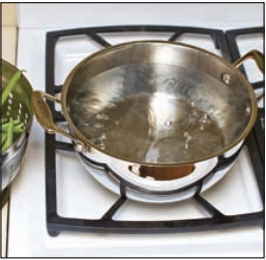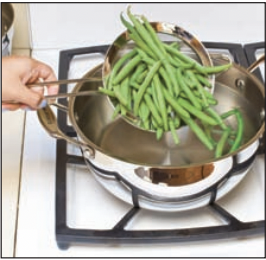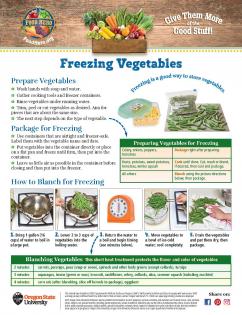Freezing Vegetables
Freezing is a good way to store vegetables
Prepare Vegetables
- Wash hands with soap and water.
- Gather cooking tools and freezer containers.
- Rinse vegetables under running water.
- Trim, peel or cut vegetables as desired. Aim for pieces that are about the same size.
- The next step depends on the type of vegetable
Preparing Vegetables for Freezing
Package right after preparing:
- Celery
- Onions
- Peppers
- Tomatoes
Cook until done. Cut, mash or blend, if desired, then cool and package:
- Beets
- Potatoes
- Sweet potatoes
- Tomatoes
- Winter squash
Blanch using the picture directions below, then package:
- All other vegetables
How to Blanch for Freezing
-
Bring 1 gallon (16 cups) of water to boil in a large pot.

2. Lower 2 to 3 cups of vegetables into the boiling water.

3. Return the water to a boil and begin timing.
2 minutes:
- carrots
- parsnips
- peas (snap or snow)
- spinach
- other leafy greens (except collards)
- turnips
3 minutes:
- asparagus
- beans (green or wax)
- broccoli
- cauliflower
- celery
- collards
- okra
- summer squash (including zucchini)
4 minutes:
- corn cob (after blanching, slice off kernels to package)
- eggplant

4. Move vegetables to a bowl of ice-cold water; cool completely.

5. Drain the vegetables and pat them dry, then package.

Enjoy Frozen Vegetables
Freezer List Reduces Waste
1. Make a list of foods already in your freezer on a piece of paper or dry erase board. Keep the list in a convenient place.
2. Label a food added to the freezer with the date it goes in and then add that food name and date to the freezer list.
3. Cross off or erase the food name from the list when it comes out of the freezer.
4. Use the oldest packages first to reduce the chance for waste. Frozen foods lose flavor and texture over time; use within 8 to 12 months.
Use Frozen Veggies Safely
- Never thaw at room temperature or in warm water.
- Thaw all the way or partway in the refrigerator or microwave just before using.
- Add frozen or partway thawed to recipes, such as soups and smoothies.
Save the Flavor of Garden Tomatoes
- Freeze tomatoes many ways: unpeeled or peeled, whole or cut, uncooked or cooked.
- Cook tomatoes first (any way you choose) to use the least amount of freezer space.
- Use frozen tomatoes in sauces or soups because their texture is soft after thawing.

Kids Can!
When kids help make healthy food, they are more likely to try it. Show kids how to:
- rinse vegetables under running water.
- keep track of blanching time.
- put vegetables on a flat pan for freezing.




